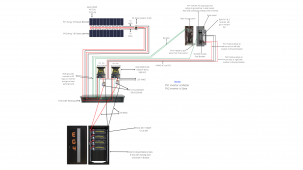Subpanel would ground to the main panel ground, no N-G bond would be made in the subpanel, since the EG4 supplies an N-G bond (is closer to power source), while inverting (turned on).
Similar to the MPP Solar LV6548 (EG4 6500EX looks like similar clone), it is known with those, that you need to break the N-G bond (remove screw inside it) on one of the inverters since you are not supposed to have more than one power source with N-G bonded. Also can create some power bleed through the ground between the two (enough to trigger ground fault detection I've heard).
Check out this video for some reference:
We also know that this style inverter only bonds N-G inside it when inverter is turned on, but when the inverter is turned off (in bypass), a relay in each inverter opens the internal N-G bonds (so that the N-G bond is then being provided by the upstream AC grid power panel.
Seems the solution they found was to remove a screw in one of the inverters (like the slave one), which permanently breaks the N-G bond in one of the 2 inverters (so there is only one bond)...
I still haven't installed my LV6548s yet so I have only read all the threads on this and haven't actually experienced any of the issues first hand some people have found here. But basically the NEC states that there should only be one N-G bond, as close to the power source as possible, so in the case of the input AC grid panel, just leave that N-G bond as normal (since it is more the power source seeing the inverters as an appliance (for pass-thru and grid battery charging) when inverters are in bypass, and then when inverters are turned on (inverting), only one of the inverters should be providing the N-G bond, and all the other ones disabled (by removing the N-G bond screw in them)...
 Hi,
Hi,



